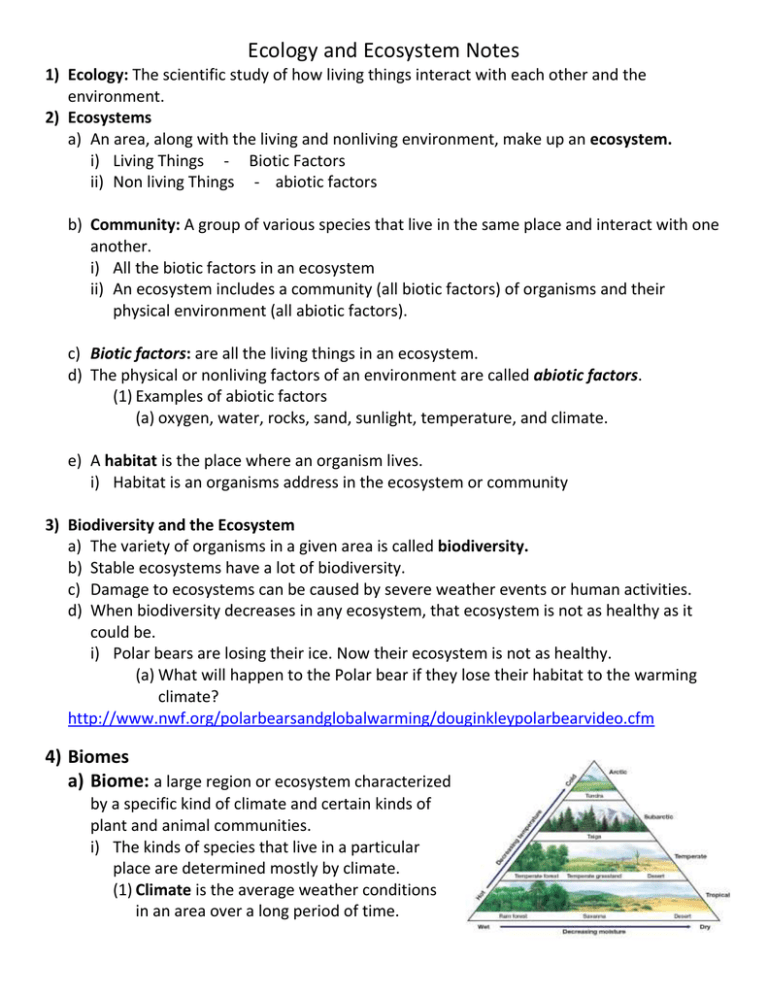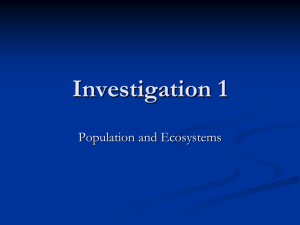Notes Chapter 4 Ecosystems & Biomes
advertisement

Ecology and Ecosystem Notes 1) Ecology: The scientific study of how living things interact with each other and the environment. 2) Ecosystems a) An area, along with the living and nonliving environment, make up an ecosystem. i) Living Things - Biotic Factors ii) Non living Things - abiotic factors b) Community: A group of various species that live in the same place and interact with one another. i) All the biotic factors in an ecosystem ii) An ecosystem includes a community (all biotic factors) of organisms and their physical environment (all abiotic factors). c) Biotic factors: are all the living things in an ecosystem. d) The physical or nonliving factors of an environment are called abiotic factors. (1) Examples of abiotic factors (a) oxygen, water, rocks, sand, sunlight, temperature, and climate. e) A habitat is the place where an organism lives. i) Habitat is an organisms address in the ecosystem or community 3) Biodiversity and the Ecosystem a) The variety of organisms in a given area is called biodiversity. b) Stable ecosystems have a lot of biodiversity. c) Damage to ecosystems can be caused by severe weather events or human activities. d) When biodiversity decreases in any ecosystem, that ecosystem is not as healthy as it could be. i) Polar bears are losing their ice. Now their ecosystem is not as healthy. (a) What will happen to the Polar bear if they lose their habitat to the warming climate? http://www.nwf.org/polarbearsandglobalwarming/douginkleypolarbearvideo.cfm 4) Biomes a) Biome: a large region or ecosystem characterized by a specific kind of climate and certain kinds of plant and animal communities. i) The kinds of species that live in a particular place are determined mostly by climate. (1) Climate is the average weather conditions in an area over a long period of time. ii) Two key factors of climate are temperature and precipitation. iii) Most organisms are adapted to live within a particular range of temperatures and cannot survive at temperatures too far above or below that range. (1) Could a polar bear survive in Utah? 5) Examples of Biomes a) Tropical rain forests receive large amounts of rain and are warm all year. They have the greatest biodiversity of any land biome. i) 100 or more inches or rain per yearly ii) Over half of all land species live in the rain forest b) Savannas are tropical grasslands that have long dry seasons and shorter wet seasons. i) More than 10 inches less than 100 inches per year c) Deserts get very little rain. Because deserts are drier, they have fewer plants and animals than other biomes. i) Less than 10” of rain per year ii) Look out the window (this is where we live d) Temperate grasslands have moderate precipitation and cooler temperatures than savannas do. Temperate grasslands are often used for agriculture. e) Deciduous forests are forest made of trees who’s leaves fall off (oak trees, maple trees) f) Coniferous forest: forest made of evergreen trees. Trees with pine needles. g) The tundra gets very little rain, so plants are short. Much of the water in the soil is not available because the water is frozen for most of the year. i) Tundra gets very little water (like a frozen desert) 6) Mountains have multiple biomes i) Elevation effects climate and biomes similar to latitudes. ii) Higher elevation is similar to higher latitudes 7) Aquatic Ecosystems a) 1. Freshwater ecosystems are located in bodies of fresh water, such as lakes, ponds, and rivers. These ecosystems have a variety of plants, fish, arthropods, mollusks, and other invertebrates. b) 2. Wetlands provide a link between the land and fully aquatic habitats. Water-loving plants dominate wetlands. Wetlands moderate flooding and clean the water that flows through them. (swamps) c) 3. An estuary is an area where fresh water from a river mixes with salt water from an ocean. d) 4. Marine ecosystems are found in the salty waters of the oceans. (This is where you can find Nemo) 8) Succession a) The replacement of one kind of community by another at a single place over a period of time is called succession. b) Two kinds of Succession: Primary and Secondary i) Primary is succession on a brand new land, like a new volcanic island ii) Secondary succession happens on old land that has been destroyed or disrupted by something. (1) Fires, floods, earthquakes, volcano’s can bring on secondary succession c) Succession is basically growing an ecosystem one species at a time d) The first organisms to appear in a newly made habitat are often called pioneer species. They change the habitat in such a way that other species can live in the ecosystem. i) Examples of pioneer species are lichens, mosses and small fast growing plants (grasses and weeds). ii) Next new species will replace the pioneer species. e) An ecosystem responds to change in such a way that the ecosystem is restored to equilibrium. i) Equilibrium is reached when the ecosystems stops changing. f) For example, when a tree falls down in a rain forest, the newly vacant patch proceeds through succession until the patch returns to its original state (a state of equilibrium). g) Sometimes, the ecosystem will find an equilibrium in which different species dominate after a change. i) Equilibrium means that the ecosystems reaches a point where it stops growing






